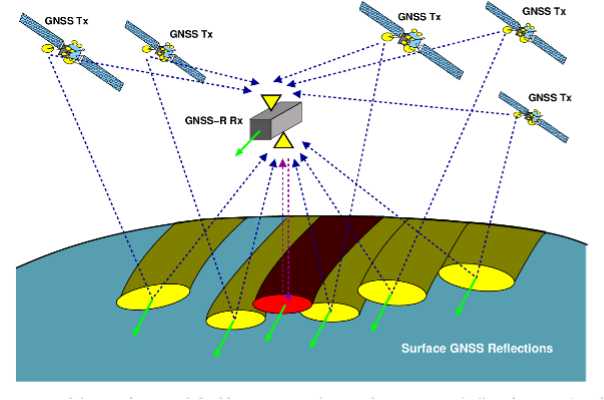GNSS-R: Formation flying of small satellites
-
Project and Master Subjects 2025-2026
- Super-agile operation of small satellites
- Early warning fault detection for satellite operations based on telemetry
- Semi-controlled re-entry for a satellite using attitude control
- System identification of environmental effects for a satellite during re-entry
- Mu-analysis for agile satellite attitude control maneuvers
- Enabling high-accuracy HYPSO image georeferencing by high-accuracy satellite pose estimation through postprocessing of satelitte sensor data
- High-accuracy attitude determination of Earth observation satellites
- Starlink: Signals of Opportunity positioning, navigation and timing (PNT)
- GNSS-R: Simulator design of a GNSS-Reflectometry simulator
- GNSS-R: Payload and embedded SW design
- GNSS-R: GNSS jamming and spoofing source localization from space
- GNSS-R: Formation flying of small satellites
- GNSS-R: Novel ship-detection methods for GNSS-Reflectometry
- Automatic Satellite Telemetry Anomaly Detection and Trend Analysis
- Which works better, explainable AI or black-box AI?
- Integrating the HYPSO constellation with the Copernicus Suite
- Explainable AI on a GPU
- What can the HYPSO-3 Hyperperspectral Cameras Observe?
- Could a short-wave infrared hyperspectral imager characterize oil spills?
- Coordinated Planning between a satellite constellation and a Autonomous Surface Vehicle
- Calibration of Hyperspectral camera point-spread function
- Past Projects
GNSS-R: Formation flying of small satellites (F25/S26)
Project Description
GNSS signal interference can be caused by jamming/spoofing events. Small satellites are a promising technology for the identification and localization of these events. At NTNU we hypothesize that a similar payload used for traditional GNSS reflectometry also can be utilized to GNSS interference (RFI) monitoring and source localization. However, accurate localization for using certain techniques such as time difference of arrival require the signal disruption to be collected by two satellites at the same time for near real time detection. For this reason, two or more satellite in formation flight are a very suitable design choice.
To assess the usability of the principle, we have developed a coverage simulator using Python with the SkyField library for orbital computations. This GNSS-R simulator can be used to evaluate the expected coverage for receiving GNSS interference signals from the ground, as well as for other use cases.
About Global Navigation Satellite System Reflectometry (GNSS-R)

GNSS-R operates as a bi-static radar using Earth-illuminating GNSS signals from GPS, GLONASS, Beidou, and Galileo satellites at around 20,000 km altitude. These signals, reflected off the Earth's surface and objects, can be measured by LEO satellite antenna receivers at about 600 km altitude. By installing an GNSS antenna on the zenith side and a GNSS-R antenna on the nadir side of the LEO satellites, 3D positioning of reflective points and analysis of surface in the glistering zone is possible.
Until recently, the primary remote sensing applications of spaceborne GNSS-R focus on the analysis of the sea-state (local wind speed, sea surface roughness, sea altimetry), soil moisture, biomass and vegetation estimation, sea-ice sheets analysis (height, volume, sea/ice index) and tsunami warning. An early study has also shown that oil spills can be detected. We will focus on the ability to detect and localize anomalies near the ocean surface. GNSS interference is also an option.
Impact
Space technology plays a crucial role in achieving various Sustainable Development Goals (SDGs) set by the UN. GNSS-R has the capability to be an all-weather, near real-time detection space-based surveillance system independent clouds and systems based on trust and self-reporting such as AIS. GNSS-R has the potential to allows us to detect and monitor water vessels at sea and localize GNSS inference sources originating from sea or land. This project target
Space technology plays a crucial role in achieving various Sustainable Development Goals (SDGs) set by the UN. GNSS-R has the capability to be an all-weather, near real-time detection space-based surveillance system independent clouds and systems based on trust and self-reporting such as AIS. In Norway, space has a crucial role to play in our collective security and monitoring of critical infrastructure and the Arctic region. GNSS-R has the potential to allows us to detect and monitor water vessels at sea and localize GNSS inference sources originating from sea or land. This project target
-
SDG9 Industry, innovation, and infrastructure. The outcomes have an innovative and commercial potential for industry and can contribute both to new space-based infrastructure and protection of existing critical infrastructure beyond GNSS.
-
SDG16 Peace, justice and strong institutions. Maritime surveillance and GNSS interference monitoring are both relevant for this.
Tasks
The student should expand the simulator developed at the SmallSatLab for formation flight analysis. The main outcome of this study should be an analysis of how different distances between the satellites affect the results of the localization estimation algorithm
Who We Are Looking For
We are seeking a highly motivated final year student in Cybernetics, or a related field with an interest in satelite control.
How we work
The student will be part of the NTNU SmallSat lab, a lab which typically hosts 10-20 master's student per semester. At the NTNU SmallSat Lab we encourage collaboration and try to get our group to help each other. To facilitate this, we as well as arrange common lunches and workshops where the students and supervisors can learn from each other. I some project we also implement a development process.
Supervisor(s)
For further questions please contact:
- Tommy Gravdahl (main supervisor, NTNU/ITK)
- Roger Birkeland (co-supervisor, NTNU/IES)
- Corrado Chiatante (co-supervisor, NTNU/IES)
